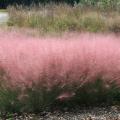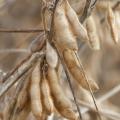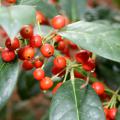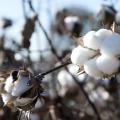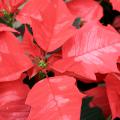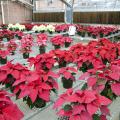News From 2011
The poinsettia may be the quintessential holiday plant because of its bright and colorful bracts, but there are some non-traditional plants that can be just as festive and spread as much cheer.
One of the most unusual I’ve seen is a miniature cherry tomato in full fruit, displayed for holiday sales.
I have admired Rex begonia for many years, and I think this group of plants has the potential to be more than a beautiful indoor plant. It could take its place as a cornerstone of holiday decorations.
I saw one of the most beautiful sights the other morning just as the sun came up. Ornamental grasses, backlit by the sun, seemed to glow in the rich morning light.
I realized at that moment that landscape grasses can have a significant impact in winter gardens.
Most gardeners already know that ornamental grasses are fantastic garden plants, but we tend to take them for granted because they perform so consistently. We just expect them to do their job and be beautiful, and we don’t give them much thought. That ought to change.
MISSISSIPPI STATE – Despite a tough economy, poultry remained the top commodity in Mississippi, with a preliminary estimated value of $2.4 billion for 2011.
While the total estimated value of poultry was up by only a fraction of a percentage point, the estimated value of eggs increased by 24 percent. Both broiler and chicken values decreased slightly in 2011.
MISSISSIPPI STATE – A poor lending environment, high prices and strong demand all played their part in soybeans’ posting another record year in Mississippi, with an estimated 2011 value of $860 million.
This makes soybeans the state’s most valuable row crop and the third most valuable ag commodity, coming in behind poultry at No. 1 and forestry at No. 2. The state had an estimated $6.7 billion value of agricultural production in 2011.
MISSISSIPPI STATE – Mississippi’s agricultural commodities are predicted to reach a record-high value of more than $6.7 billion for 2011.
Mississippi State University Extension Service economists compiled the numbers from poultry, forestry, agronomic crops, catfish and livestock for the annual value estimate. If government payments are factored in, the state’s value of production reaches $7 billion for the first time in history.
Setting up wireless Internet access for your home or home office may sound daunting, but with careful attention to detail and a little patience, it can be done in an afternoon.
First, decide whether wireless Internet access is right for your home. There are several benefits to wireless access. For example, it can allow you to use the Internet from anywhere in the house without being tied to a network cable. It also allows you to connect multiple devices (computers, iPads, gaming consoles) to the network.
As Christmas wrapping paper litters the living room floor, gift recipients eagerly tinker with their new gadgets and gizmos. But what should they do with their old computers, cell phones and monitors?
According to the Environmental Protection Agency, Americans abandon 12 million to 14 million computers each year. Of those, 75 percent are stored in closets, and 50 percent of those could be donated.
MISSISSIPPI STATE – Making resolutions together can bring a family closer and provide a support system for choosing healthier behaviors in the new year.
MISSISSIPPI STATE – Low national home construction levels and relatively dry weather resulted in a slightly lower year-end harvest value for Mississippi forest products, but the preliminary estimate still exceeds $1 billion.
MISSISSIPPI STATE – An administrator with almost 20 years of experience as an Extension educator at Mississippi State University is serving as interim head of the Extension service’s statewide youth program.
Paula Threadgill will lead the Department of 4-H Youth Development, pending final approval. She will continue as leader for Extension Family and Consumer Sciences.
Gary Jackson, director of the MSU Extension Service, said Threadgill brings a wealth of knowledge and experience to the 4-H program.
When the weather outside is frightful and nothing is blooming, gardeners must rely on plant features other than flowers for color.
Plants that produce colorful berries can enhance the winter landscape. Mississippi gardeners are lucky because we have some real beauties to help shake up the winter landscape.
MISSISSIPPI STATE – The majority of Mississippi’s farms are family-owned, and they not only put fresh produce on the table but also contribute significantly to the state’s No. 1 industry, agriculture.
Products of small farms tend to be sold locally, while those from large farms are usually sold as raw commodities for animal feed or further processing before being purchased by consumers. Both have their roles in food and fiber production in Mississippi.
MISSISSIPPI STATE--The dairy products judging team at Mississippi State University is the “cream of the crop,” placing third overall in the national 90th Collegiate Dairy Products Evaluation Contest.
The six-member team also took second in ice cream and cottage cheese evaluation, and third in cheddar cheese.
MISSISSIPPI STATE – Loren “Wes” Burger Jr. has been named associate director of the Mississippi Agricultural and Forestry Experiment Station and the Forest and Wildlife Research Center at Mississippi State University effective Dec. 15.
As associate director, Burger will manage all sponsored programs in MAFES and FWRC and work on other related projects.
Gifts for the technology lover do not have to be confusing or expensive, and there are many options that can help fill in spaces under the tree without breaking the bank.
My mother referred to these smaller items as “filler” presents. If we woke up Christmas morning to find a shiny bicycle beside the tree, we knew that every other present underneath the tree would be socks and underwear.
Besides the Christmas tree, the poinsettia is the plant most often associated with the Christmas season. You can hardly go wrong with their colorful bracts brightening your decorations.
The color spectrum of poinsettia is truly remarkable. Colors range from red to white to even maroon, making it hard to choose favorites. There are bicolored, speckled and marbled poinsettias. And if that’s not enough, growers are even painting leaves and adding glitter.
MISSISSIPPI STATE – Mississippi State University’s Extension Service has selected Trent Irby as the new soybean specialist to assist the state’s soybean growers.
Irby, a Mississippi native, has research and practical experience that make him uniquely suited to help support the state’s nearly $1 billion per year soybean industry, said Gary Jackson, director of MSU’s Extension Service.
MISSISSIPPI STATE – Researchers at Mississippi State University have found a cost-effective and environmentally friendly strategy for fighting one of the most serious soil-borne diseases in poinsettia production.
Pythium stem and root rot is a common problem in poinsettia production because the fungus thrives in cool, saturated and poorly drained soils, said Maria Tomaso-Peterson, associate research professor in MSU’s Department of Biochemistry, Molecular Biology, Entomology and Plant Pathology.
The holidays are quickly approaching, and little ones have begun the eager countdown to Christmas morning. A tradition in many families is to write a letter to Saint Nick, and many tech-savvy children are turning to the Internet to get their letters to Santa in on time.
MISSISSIPPI STATE – Kudzu can grow a foot per day, and today it covers nearly seven million acres in the South.
Now listed as a federal noxious weed, kudzu was imported to prevent soil erosion and to feed livestock. The semi-woody plant covers large tracts of land from eastern Texas to the East Coast and as far north as Maryland. Kudzu climbs, covers and eventually kills trees, destroying the timber-producing value of these lands. It reduces land productivity by millions of dollars yearly.
Pages
News Types
- Crop Report (427)
- Feature Story (5904)
- Feature Photo (53)
- Extension Outdoors (319)
- Southern Gardening (1479)
- Extension Inbox (95)
Archive
- 2025 (93)
- 2024 (186)
- 2023 (182)
- 2022 (183)
- 2021 (176)
- 2020 (211)
- 2019 (222)
- 2018 (276)
- 2017 (336)
- 2016 (381)
- 2015 (456)
- 2014 (495)
- 2013 (487)
- 2012 (491)
- 2011 (354)
- 2010 (320)
- 2009 (313)
- 2008 (272)
- 2007 (263)
- 2006 (252)
- 2005 (278)
- 2004 (270)
- 2003 (279)
- 2002 (227)
- 2001 (238)
- 2000 (241)
- 1999 (231)
- 1998 (231)
- 1997 (239)
- 1996 (58)
- 1995 (36)


